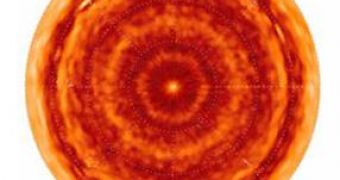A surprising new finding of the Cassini-Huygens probe reveals that Saturn presents spinning hot spots at each pole, that can resist even to the toughest polar winters, but whatever causes them seems to surpass scientific explanations so far.
Saturn's hotspots, located in its gaseous atmosphere hovering over the poles, are considered to be hot air structures surrounding that respective area. Data sent back by Cassini actually shows that the temperature of the hotspots at its poles is close to that of its atmosphere along the equatorial regions. Scientists were more interested in studying Saturn's southern polar regions rather than the north one, which has been pointing towards our planet for more than a decade, due to the gas giant's long orbit around the Sun, thus the existence of such structure around its south pole remained undiscovered until late last year when Cassini got a better look.
Scientists previously believed that such hotspots are generated when the south pole is pointing towards the Sun, as it receives a greater amount of sunlight than the north one, but the discovery of a similar structure around the northern regions during the winter phase, which lasts many years at a time, quickly dismissed this theory.
Alternatively, a second explanation takes into consideration the fact that the air is pulled in a downwards motion towards the interior of the planet, while the displaced mass of air from the inner regions of Saturn rise upwards to create a circular feature around the hotspot. Such huge air movements are usually powered by massive atmospheric storms, very similar in behavior to those experienced on Earth during hurricanes.
Although both poles present hotspots, the south pole region poses a slight problem to the second theory, since it does not show the hexagonal circular pattern around the hotspot that should be generated if the explanation is correct. The really intriguing aspect of the mystery is that the Earth, like Saturn, presents a similar pattern, with preferential location of the hexagonal circular structure around the north pole.
Other missions sent to study the gas planets in the remote areas of the solar system also revealed hotspots on Jupiter and Neptune, and all evidences suggest that this might be a property of all gaseous planets and rocky planets with dense atmospheres, and maybe even of other extrasolar planets.

 14 DAY TRIAL //
14 DAY TRIAL //